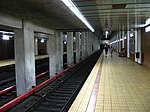Politehnica University of Bucharest
1864 establishments in RomaniaEducational institutions established in 1864Engineering universities and colleges in RomaniaModernist architecture in RomaniaPolitehnica University of Bucharest
Politehnica University of Bucharest (Romanian: Universitatea Politehnica din București) is a technical university in Bucharest, Romania. 200 years of activity have been celebrated lately, as the university was founded in 1818. Politehnica University is classified by the Ministry of Education as an advanced research and education university.The University is a member of European Association for International Education (EAIE), European University Association (EUA), EUA Council for Doctoral Education, CESAER (council of universities of science and technology in Europe), and the Romanian Alliance of Technical Universities (ARUT).
Excerpt from the Wikipedia article Politehnica University of Bucharest (License: CC BY-SA 3.0, Authors).Politehnica University of Bucharest
Bulevardul Doina Cornea, Bucharest Militari
Geographical coordinates (GPS) Address Website External links Nearby Places Show on map
Geographical coordinates (GPS)
| Latitude | Longitude |
|---|---|
| N 44.438333333333 ° | E 26.051388888889 ° |
Address
Universitatea Politehnica din București
Bulevardul Doina Cornea
060042 Bucharest, Militari
Romania
Open on Google Maps











